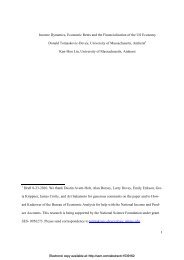Corporate governance and firm valuation
Corporate governance and firm valuation
Corporate governance and firm valuation
You also want an ePaper? Increase the reach of your titles
YUMPU automatically turns print PDFs into web optimized ePapers that Google loves.
414 L.D. Brown, M.L. Caylor / Journal of Accounting <strong>and</strong> Public Policy 25 (2006) 409–434<br />
the relation between IRRC corporate <strong>governance</strong> data <strong>and</strong> <strong>firm</strong> value, we show<br />
that a small subset of factors fully drives the relation between ISS corporate<br />
<strong>governance</strong> data <strong>and</strong> <strong>firm</strong> value. Similar to Cremers <strong>and</strong> Nair (2005), weshow<br />
that links between <strong>governance</strong> <strong>and</strong> <strong>firm</strong> value are not confined to anti-takeover<br />
measures. In contrast to past studies, we use a single database containing<br />
numerous internal <strong>and</strong> external <strong>governance</strong> factors, <strong>and</strong> we identify five internal<br />
<strong>governance</strong> factors that have not heretofore been linked to <strong>firm</strong> <strong>valuation</strong>. We<br />
are also the first researchers to examine the link between <strong>firm</strong> value <strong>and</strong> five <strong>governance</strong><br />
provisions that are related either to auditing or stock option expensing,<br />
<strong>and</strong> we show that no significant <strong>and</strong> positive relation exists between these corporate<br />
<strong>governance</strong> factors <strong>and</strong> <strong>firm</strong> <strong>valuation</strong>.<br />
3. Data <strong>and</strong> methodology<br />
3.1. Sample selection<br />
We create a summary corporate <strong>governance</strong> index, Gov-Score, for 1868<br />
<strong>firm</strong>s as of February 1, 2003. 11 We use February 1, 2003 because it precedes<br />
the effective dates of both the relevant provisions of the Sarbanes–Oxley Act<br />
<strong>and</strong> those enacted by major US stock exchanges. 12 We code each of 51 factors<br />
either 1 or 0 depending on whether or not ISS considers the <strong>firm</strong>’s <strong>governance</strong><br />
to be minimally acceptable. 13 We determine if a <strong>firm</strong>’s <strong>governance</strong> is minimally<br />
11<br />
ISS began collecting <strong>firm</strong>-specific corporate <strong>governance</strong> data from <strong>firm</strong>s’ proxy statement in mid<br />
2002, exp<strong>and</strong>ing the number of <strong>governance</strong> factors it collected in late January 2003.<br />
12<br />
If we examined later years, many provisions would be m<strong>and</strong>atory <strong>and</strong> exhibit little variation to<br />
conduct empirical tests.<br />
13<br />
ISS provides 61 individual measures <strong>and</strong> three combination measures. We omit combination<br />
factors <strong>and</strong> we separate one factor into two (poison pill <strong>and</strong> blank check preferred stock). We omit<br />
10 factors which apply only to a subset of <strong>firm</strong>s: poison pill with TIDE provision, poison pill with<br />
sunset provision, poison pill with a qualified offer clause, <strong>and</strong> poison pill has trigger threshold, not<br />
incorporated in a state with a control share acquisition statute or company opted out,<br />
not incorporated in a state with a control share cash-out statute or company opted out, not<br />
incorporated in a state with a freeze-out provision or company has opted out, not incorporated in a<br />
state with a fair price provision or company has opted out, not incorporated in a state with state<br />
stakeholder laws or company opted out, <strong>and</strong> not incorporated in a state that endorses poison pills.<br />
Consistent with GIM <strong>and</strong> BCF, we omit <strong>firm</strong>s with dual class stock. ISS does not code data as<br />
representing minimally acceptable <strong>governance</strong> but they provide sufficient information to enable one<br />
to make such a determination. We determine if a <strong>firm</strong>’s <strong>governance</strong> is minimally acceptable (coded<br />
1) or unacceptable (coded 0) by perusing the detailed ISS data <strong>and</strong> using information in ISS<br />
<strong>Corporate</strong> Governance: Best Practices User Guide <strong>and</strong> Glossary (2003). Similar to GIM, BCF <strong>and</strong><br />
Cremers <strong>and</strong> Nair (2005), we rely on the data provider’s view as to what constitutes good<br />
<strong>governance</strong> rather than make our own assessments.







